Spring源码学习之IOC实现原理(二)-ApplicationContext
一.Spring核心组件结构
总的来说Spring共有三个核心组件,分别为Core,Context,Bean.三大核心组件的协同工作主要表现在 :Bean是包装我们应用程序自定义对象Object的,Object中存有数据,而Context就是为了这些数据存放提供一个生存环境,保存各个 bean之间的对应关系,并且维护好这些对应关系。Context就是一个Bean关系的集合,也就是我们所谓的IOC容器。Core就是Context 在发现、建立、维护Bean之间关系所需要的一些工具,如资源的加载,资源的抽象等。 (《深入分析Java Web技术内幕》)
1.Bean组件
前面介绍的BeanFactory体系就属于Bean组件,位于org.springframework.beans子包factory包下面。这个包主要解决三个问题,Bean的定义,Bean的创建,Bean的解析。
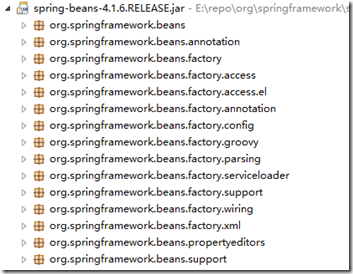
1. org.springframework.beans, 包含了操作java bean的接口和类。This package contains interfaces and classes for manipulating Java beans. It is used by most other Spring packages. ***
2. org.springframework.beans.annotation, 支持包,提供对java 5注解处理bean样式的支持。
3. org.springframework.beans.factory, 实现spring轻量级IoC容器的核心包。***
4. org.springframework.beans.factory.access, 定位和获取bean工程的辅助工具类。
5. org.springframework.beans.factory.access.el,从统一样式的EL 获取spring beanFactory的支持类
6. org.springframework.beans.factory.annotation, 配置基于注解驱动的bean的支持包。***
7. org.springframework.beans.factory.config, bean工厂的SPI接口和配置相关的处理类。
8. org.springframework.beans.factory.parsing, bean definition解析的支持基础类
9. org.springframework.beans.factory.serviceloader, jdk1.6 ServiceLoader基础类的支持包。
10. org.springframework.beans.factory.support,org.springframework.beans.factory包的支持类
11. org.springframework.beans.factory.wiring, 一种决定一个bean实例的元数据的机制。
12. org.springframework.beans.factory.xml, 包含了一个基于xml的beanFactory实现,也包含一个标准的spring-beans的dtd
13. org.springframework.beans.propertyeditors, 属性编辑器,用来将string类型的值转换为object类型,例如:java.util.Properties
14. org.springframework.beans.support,org.springframework.beans的支持包,像:一组bean的排序和保持工具类等
Bean的定义由BeanDefinition抽象出来,也是IOC容器的内部数据结构。BeanDefinition完整的描述了xml文件中关于<bean>节点的所有信息。当Spring解析一个<bean>节点后,在IOC容器内部就会转换为BeanDefinition对象。而最终实例化时,所使用的对象就是RootBeanDefinition对象。
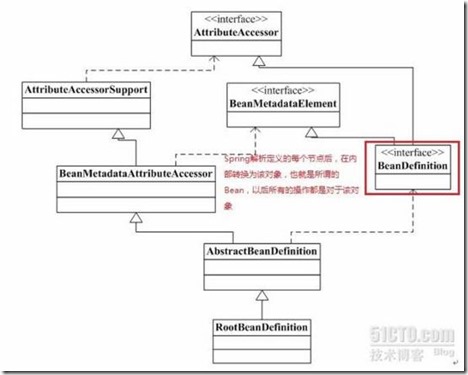
Bean的创建,采用的是典型的工厂模式,采用的体系即(一)中所说的BeanFactory体系结构。主要的类是DefaultListableBeanFactory,其完整的实现了IOC容器的功能。
Bean的解析,主要就是对于Spring的配置文件进行解析处理,从中解析出相应的信息以用来生成Bean的对象。 其中主要用于解析的实现类就是DefaultBeanDefinitionDocumentReader。
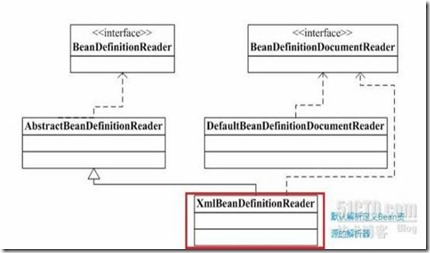
2.Core组件
Core组件作为Spring的核心组件,其中包含了很多关键类,一个重要的组成部分就是定义了资源的访问方式。如之前用到的ClassPathResource就是其中的一个典型的资源抽象形式。资源的顶级接口为Resource,它继承自InputStreamSource,实现了其getInputStream方法,返回的是InputStream类。这样所有的资源就是通过该方法来获取输入流的。对于资源的加载,也实现了统一,屏蔽了资源提供者。定义了一个资源加载顶级接口 ResourceLoader ,它默认的加载就是DefaultResourceLoader。

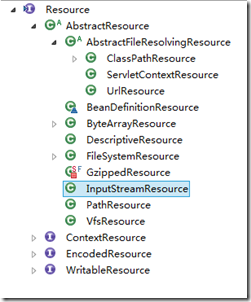
2.1InputStreamSource
该接口只有一个抽象方法
public interface InputStreamSource {
/**
* Return an {@link InputStream}.
*/
InputStream getInputStream() throws IOException;
}
2.2 Resource
作为顶级接口,也是再各个类中调用资源时应用最为广泛的接口,充分体现了面向接口编程的思想。
/**
* Interface for a resource descriptor that abstracts from the actual
* type of underlying resource, such as a file or class path resource.
*/
public interface Resource extends InputStreamSource { boolean exists();
boolean isReadable(); boolean isOpen(); URL getURL() throws IOException; URI getURI() throws IOException; File getFile() throws IOException; long contentLength() throws IOException; long lastModified() throws IOException; Resource createRelative(String relativePath) throws IOException; String getFilename(); String getDescription(); }
这就是该接口定义的方法,都是显而易见的方法,同时也是对于资源类来说应用最多的方法。
2.3ClassPathResource
/**
* This implementation opens an InputStream for the given class path resource.
* @see java.lang.ClassLoader#getResourceAsStream(String)
* @see java.lang.Class#getResourceAsStream(String)
*/
@Override
public InputStream getInputStream() throws IOException {
InputStream is;
if (this.clazz != null) {
is = this.clazz.getResourceAsStream(this.path);
}
else if (this.classLoader != null) {
is = this.classLoader.getResourceAsStream(this.path);
}
else {
is = ClassLoader.getSystemResourceAsStream(this.path);
}
if (is == null) {
throw new FileNotFoundException(getDescription() + " cannot be opened because it does not exist");
}
return is;
}
该方法就是ClassPathResource的getInputStream方法,可以发现其主要通过class类或者ClassLoader来返回InputStream。而之前的分析可知,当loadBeanDefinition时,最终应用的是InputSource inputSource = new InputSource(inputStream);InputSource,属于org.xml.sax包,是一个XML形式的输入流。
3.Context组件
Context组件在Spring的org.springframework.context包下,它的作用主要是给Spring提供一个运行时的环境,用以保证各个对象的状态。其中ApplicationContext是Context的顶级父类接口,它除了继承一个能表示应用环境的基本信息接口外,还继承了5个接口,这5个接口扩展了Context的功能。
public interface ApplicationContext extends EnvironmentCapable, ListableBeanFactory, HierarchicalBeanFactory, MessageSource, ApplicationEventPublisher, ResourcePatternResolver
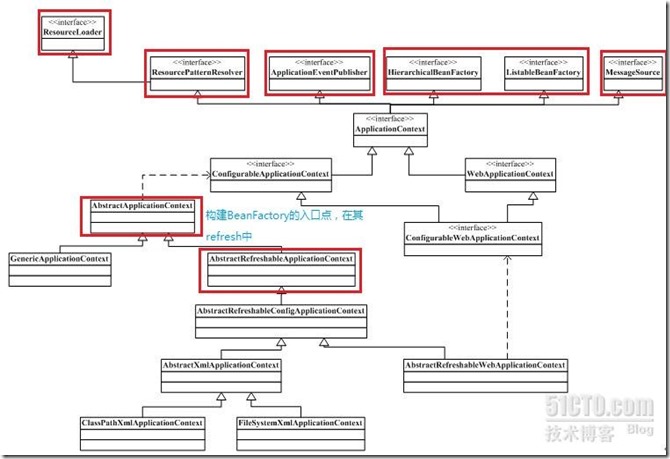
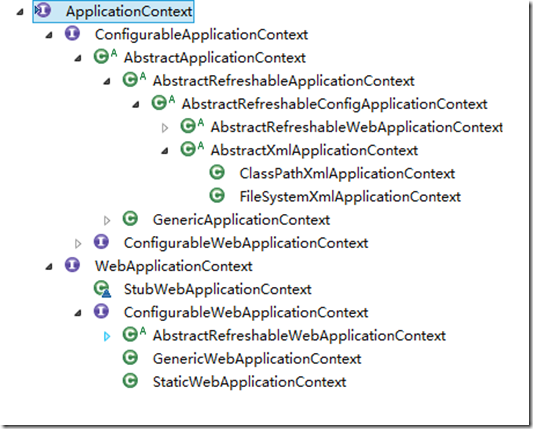
可以发现其主要应用子类为ClassPathXmlApplicationContext,FileSystemXmlApplicationContext,以及应用在Web上的XmlWebApplicationContext.
二. ApplicationContext源码详解
在ApplicationContext的设计中,一方面可以看到它继承了BeanFactory接口体系结构的ListableBeanFactory, HierarchicalBeanFactory,具备了IOC容器的基本功能;另一方面,通过继承MessageSource, ApplicationEventPublisher, ResourcePatternResolver这些接口,使得其被赋予了更高级别的特性。
1.java doc
/**
* Central interface to provide configuration for an application.
* This is read-only while the application is running, but may be
* reloaded if the implementation supports this.
*
* <p>An ApplicationContext provides:
* <ul>
* <li>Bean factory methods for accessing application components.
* Inherited from {@link org.springframework.beans.factory.ListableBeanFactory}.
* <li>The ability to load file resources in a generic fashion.
* Inherited from the {@link org.springframework.core.io.ResourceLoader} interface.
* <li>The ability to publish events to registered listeners.
* Inherited from the {@link ApplicationEventPublisher} interface.
* <li>The ability to resolve messages, supporting internationalization.
* Inherited from the {@link MessageSource} interface.
* <li>Inheritance from a parent context. Definitions in a descendant context
* will always take priority. This means, for example, that a single parent
* context can be used by an entire web application, while each servlet has
* its own child context that is independent of that of any other servlet.
* </ul>
*
* <p>In addition to standard {@link org.springframework.beans.factory.BeanFactory}
* lifecycle capabilities, ApplicationContext implementations detect and invoke
* {@link ApplicationContextAware} beans as well as {@link ResourceLoaderAware},
* {@link ApplicationEventPublisherAware} and {@link MessageSourceAware} beans.
*
* @author Rod Johnson
* @author Juergen Hoeller
* @see ConfigurableApplicationContext
* @see org.springframework.beans.factory.BeanFactory
* @see org.springframework.core.io.ResourceLoader
*/
ApplicationContext添加的功能主要表现在 :
1)可以支持不同的信息源,它扩展了MessageSource,支持国际化。
2)访问资源,主要就是ResourceLoader的继承,这样可以从不同地方得到bean定义的资源。
3)支持应用事件,继承了ApplicationEventPublisher, 这样在上下文中引入了事件机制。
2.源码
public interface ApplicationContext extends EnvironmentCapable, ListableBeanFactory, HierarchicalBeanFactory,
MessageSource, ApplicationEventPublisher, ResourcePatternResolver { /**
* Return the unique id of this application context.
* @return the unique id of the context, or {@code null} if none
*///返回标志Context的Id编号
String getId(); /**
* Return a name for the deployed application that this context belongs to.
* @return a name for the deployed application, or the empty String by default
*/
//返回context所属应用名称
String getApplicationName(); /**
* Return a friendly name for this context.
* @return a display name for this context (never {@code null})
*/
String getDisplayName(); /**
* Return the timestamp when this context was first loaded.
* @return the timestamp (ms) when this context was first loaded
*/
//返回loaded时间戳
long getStartupDate(); /**
* Return the parent context, or {@code null} if there is no parent
* and this is the root of the context hierarchy.
* @return the parent context, or {@code null} if there is no parent
*/
//返回双亲ApplicationContext,证明这里是有层次关系的
ApplicationContext getParent(); /**
* Expose AutowireCapableBeanFactory functionality for this context.
* <p>This is not typically used by application code, except for the purpose of
* initializing bean instances that live outside of the application context,
* applying the Spring bean lifecycle (fully or partly) to them.
* <p>Alternatively, the internal BeanFactory exposed by the
* {@link ConfigurableApplicationContext} interface offers access to the
* {@link AutowireCapableBeanFactory} interface too. The present method mainly
* serves as a convenient, specific facility on the ApplicationContext interface.
* <p><b>NOTE: As of 4.2, this method will consistently throw IllegalStateException
* after the application context has been closed.</b> In current Spring Framework
* versions, only refreshable application contexts behave that way; as of 4.2,
* all application context implementations will be required to comply.
* @return the AutowireCapableBeanFactory for this context
* @throws IllegalStateException if the context does not support the
* {@link AutowireCapableBeanFactory} interface, or does not hold an
* autowire-capable bean factory yet (e.g. if {@code refresh()} has
* never been called), or if the context has been closed already
* @see ConfigurableApplicationContext#refresh()
* @see ConfigurableApplicationContext#getBeanFactory()
*/
AutowireCapableBeanFactory getAutowireCapableBeanFactory() throws IllegalStateException; }
3.*****单步调试ApplicationContext****
仍然采用上一节所使用的例子
ApplicationContext appContext=new ClassPathXmlApplicationContext("beans.xml");
Performer performer=(Performer) appContext.getBean("dancer");
performer.perform();
(1)ApplicationContext appContext=new ClassPathXmlApplicationContext("beans.xml");
调用构造器
/**
* Create a new ClassPathXmlApplicationContext, loading the definitions
* from the given XML file and automatically refreshing the context.
* @param configLocation resource location
* @throws BeansException if context creation failed
*/
public ClassPathXmlApplicationContext(String configLocation) throws BeansException {
this(new String[] {configLocation}, true, null);
}
可以看到除了load xml定义文件外,还有自动刷新的作用。
第二个boolean参数,是refresh启动参数。
/**
* Create a new ClassPathXmlApplicationContext with the given parent,
* loading the definitions from the given XML files.
* @param configLocations array of resource locations
* @param refresh whether to automatically refresh the context,
* loading all bean definitions and creating all singletons.
* Alternatively, call refresh manually after further configuring the context.
* @param parent the parent context
* @throws BeansException if context creation failed
* @see #refresh()
*/
public ClassPathXmlApplicationContext(String[] configLocations, boolean refresh, ApplicationContext parent)
throws BeansException { super(parent);
setConfigLocations(configLocations);
if (refresh) {
refresh();
}
}
super(parent),通过逐层向上,最后会到AbstractApplicationContext.

回到上面可以看到refresh()方法即为IOC容器初始化的方法,标志着IOC容器的启动。
setConfigLocations(configLocations),设置资源属性数组
/**
* Set the config locations for this application context.
* <p>If not set, the implementation may use a default as appropriate.
*/
public void setConfigLocations(String... locations) {
if (locations != null) {
Assert.noNullElements(locations, "Config locations must not be null");
this.configLocations = new String[locations.length];
for (int i = 0; i < locations.length; i++) {
this.configLocations[i] = resolvePath(locations[i]).trim();
}
}
else {
this.configLocations = null;
}
}
(2)refresh()
该方法属于AbstractApplicationContext,即第一个抽象类。
public void refresh() throws BeansException, IllegalStateException {
synchronized (this.startupShutdownMonitor) {
// Prepare this context for refreshing.
//调用容器准备刷新的方法,获取容器的当时时间,同时给容器设置同步标识 ,log信息也是源自于这个方法
prepareRefresh();
// Tell the subclass to refresh the internal bean factory.
ConfigurableListableBeanFactory beanFactory = obtainFreshBeanFactory();
// Prepare the bean factory for use in this context.
prepareBeanFactory(beanFactory);
try {
// Allows post-processing of the bean factory in context subclasses.
postProcessBeanFactory(beanFactory);
// Invoke factory processors registered as beans in the context.
invokeBeanFactoryPostProcessors(beanFactory);
// Register bean processors that intercept bean creation.
registerBeanPostProcessors(beanFactory);
// Initialize message source for this context.
initMessageSource();
// Initialize event multicaster for this context.
initApplicationEventMulticaster();
// Initialize other special beans in specific context subclasses.
onRefresh();
// Check for listener beans and register them.
registerListeners();
// Instantiate all remaining (non-lazy-init) singletons.
finishBeanFactoryInitialization(beanFactory);
// Last step: publish corresponding event.
finishRefresh();
}
catch (BeansException ex) {
logger.warn("Exception encountered during context initialization - cancelling refresh attempt", ex);
// Destroy already created singletons to avoid dangling resources.
destroyBeans();
// Reset 'active' flag.
cancelRefresh(ex);
// Propagate exception to caller.
throw ex;
}
}
}
2.1 prepareRefresh();
为刷新Context前做准备,设定启动时间,同时Log信息同样源自这个方法。
/**
* Prepare this context for refreshing, setting its startup date and
* active flag as well as performing any initialization of property sources.
*/
protected void prepareRefresh() {
this.startupDate = System.currentTimeMillis();
this.active.set(true); if (logger.isInfoEnabled()) {
logger.info("Refreshing " + this);
} // Initialize any placeholder property sources in the context environment
initPropertySources(); // Validate that all properties marked as required are resolvable
// see ConfigurablePropertyResolver#setRequiredProperties
getEnvironment().validateRequiredProperties();
}

2.2ConfigurableListableBeanFactory beanFactory = obtainFreshBeanFactory();
刷新所有的BeanFactory子容器,同时这里涉及到了解析和载入BeanDefinition的步骤。
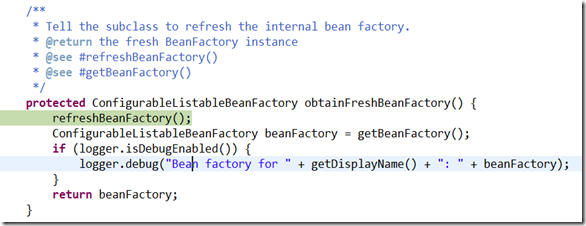
下面就分析一下BeanFactory的刷新方法refreshBeanFactory()
这里应用了委派模式,因为refreshBeanFactory()方法属于其子类AbstractRefreshApplicationContext.
/**
* This implementation performs an actual refresh of this context's underlying
* bean factory, shutting down the previous bean factory (if any) and
* initializing a fresh bean factory for the next phase of the context's lifecycle.
*/
@Override
protected final void refreshBeanFactory() throws BeansException {
if (hasBeanFactory()) {
destroyBeans();
closeBeanFactory();
}
try {
DefaultListableBeanFactory beanFactory = createBeanFactory();
beanFactory.setSerializationId(getId());
//对IoC容器进行定制化,如设置启动参数,开启注解的自动装配等
customizeBeanFactory(beanFactory);
loadBeanDefinitions(beanFactory);
synchronized (this.beanFactoryMonitor) {
this.beanFactory = beanFactory;
}
}
catch (IOException ex) {
throw new ApplicationContextException("I/O error parsing bean definition source for " + getDisplayName(), ex);
}
}
1.这里可以看到一个构建DefaultListableBeanFactory容器的过程,先是构造BeanFactory,createBeanFactory()。
2.loadBeanDefinitions(beanFactory),这里载入了beanDefinition。
接下来再深入loadBeanDefinition(beanFactory)方法
该方法属于AbstractXmlApplicationContext,又是一个委派模式,让子类来实现。
/**
* Loads the bean definitions via an XmlBeanDefinitionReader.
* @see org.springframework.beans.factory.xml.XmlBeanDefinitionReader
* @see #initBeanDefinitionReader
* @see #loadBeanDefinitions
*/
@Override
protected void loadBeanDefinitions(DefaultListableBeanFactory beanFactory) throws BeansException, IOException {
// Create a new XmlBeanDefinitionReader for the given BeanFactory.
XmlBeanDefinitionReader beanDefinitionReader = new XmlBeanDefinitionReader(beanFactory); // Configure the bean definition reader with this context's
// resource loading environment.
beanDefinitionReader.setEnvironment(this.getEnvironment());
beanDefinitionReader.setResourceLoader(this);
beanDefinitionReader.setEntityResolver(new ResourceEntityResolver(this)); // Allow a subclass to provide custom initialization of the reader,
// then proceed with actually loading the bean definitions.
initBeanDefinitionReader(beanDefinitionReader);
loadBeanDefinitions(beanDefinitionReader);
}
1.XmlBeanDefinitionReader beanDefinitionReader = new XmlBeanDefinitionReader(beanFactory); 这个与(一)中分析的过程一样,同样是创建了一个可以载入BeanDefinition的读写器,同样用DefaultListableBeanFactory作为构造器参数,从而赋予registy属性。
2.调用loadBeanDefinitions()
/**
* Load the bean definitions with the given XmlBeanDefinitionReader.
* <p>The lifecycle of the bean factory is handled by the {@link #refreshBeanFactory}
* method; hence this method is just supposed to load and/or register bean definitions.
* @param reader the XmlBeanDefinitionReader to use
* @throws BeansException in case of bean registration errors
* @throws IOException if the required XML document isn't found
* @see #refreshBeanFactory
* @see #getConfigLocations
* @see #getResources
* @see #getResourcePatternResolver
*/
protected void loadBeanDefinitions(XmlBeanDefinitionReader reader) throws BeansException, IOException {
Resource[] configResources = getConfigResources();
if (configResources != null) {
reader.loadBeanDefinitions(configResources);
}
String[] configLocations = getConfigLocations();
if (configLocations != null) {
reader.loadBeanDefinitions(configLocations);
}
}
最终调用reader.loadBeanDefinitions(configLocations);这就又回到了(一)IOC容器初始化的过程。
到这里就完成了BeanDefinition的载入,注册工作。并且最终返回了DefaultListableBeanFactory,所以BeanDefinition持有容器依然是DefaultListableBeanFactory.所以接下来的工作就应该是实例化工作。
2.3 prepareBeanFactory(beanFactory);
这是在实例化之前进行的工作。
创建好beanFactory后,添加Spring本身需要的工具类。为容器配备了ClassLoader,PropertyEditor和BeanPostProcessor.
/**
* Configure the factory's standard context characteristics,
* such as the context's ClassLoader and post-processors.
* @param beanFactory the BeanFactory to configure
*/
protected void prepareBeanFactory(ConfigurableListableBeanFactory beanFactory) {
// Tell the internal bean factory to use the context's class loader etc.
beanFactory.setBeanClassLoader(getClassLoader());
beanFactory.setBeanExpressionResolver(new StandardBeanExpressionResolver(beanFactory.getBeanClassLoader()));
beanFactory.addPropertyEditorRegistrar(new ResourceEditorRegistrar(this, getEnvironment())); // Configure the bean factory with context callbacks.
beanFactory.addBeanPostProcessor(new ApplicationContextAwareProcessor(this));
//.......
}
这里可以看到,ApplicationContextAwareProcessor作为BeanPostProcessor的实现,在这里添加。
其主要作用是当Bean实现了ApplicationContextAware接口后,当该Bean完成实例化依赖注入之后,会通过BeanPostProcessor的方式来给该Bean注入当前的ApplicationContext.从而使得该实例有能力获得ApplicationContext.
2.4 postProcessBeanFactory(beanFactory);
这个方法是预留方法,是用来对BeanFactory进行后处理的方法。
2.5 invokeBeanFactoryPostProcessors(beanFactory);
调用所有注册的BeanFactoryPostProcessor的Bean,这里也是针对BeanFactory的后置处理器的调用。
2.6 registerBeanPostProcessors(beanFactory);
BeanPostProcessor是Bean后置处理器,用于监听容器触发的事件,Bean的后置处理器。Register bean processors that intercept bean creation.这个注册主要是绑定到DefaultListableBeanFactory中取。
后置处理器向容器注册以后,容器中管理的Bean就具备了接收IoC容器事件回调的能力。
BeanPostProcessor是一个接口类,主要有两个方法,一个是postProcessBeforeInitialization,在Bean的初始化前提供回调入口;另一个是postProcessAfterInitialization,在Bean的初始化后提供回调入口。实际上,这两个后置处理器方法是一前一后围绕着Bean定义的init-method方法调用的,都是发生在populateBean()方法之后,即完成依赖注入之后发生的。
上面其实涉及到了两个Spring的扩展点,一个是BeanFactoryPostProcessor和BeanPostProcessor,他们分别在构建BeanFactory和构建Bean对象时调用,还有就是InitializationBean和DisposableBean,他们分别在Bean实例创建和销毁时被调用。
2.7 initMessageSource()和 initApplicationEventMulticaster();
初始化信息源和事件传播器。
这是由于ApplicationContext分别实现了MessageSource, ApplicationEventPublisher两个接口。
2.8 finishBeanFactoryInitialization(beanFactory)
完成BeanFactory的初始化工作,这里涉及到了对于lazy-init属性的处理。
/**
* Finish the initialization of this context's bean factory,
* initializing all remaining singleton beans.
*/
protected void finishBeanFactoryInitialization(ConfigurableListableBeanFactory beanFactory) {
// Initialize conversion service for this context.
if (beanFactory.containsBean(CONVERSION_SERVICE_BEAN_NAME) &&
beanFactory.isTypeMatch(CONVERSION_SERVICE_BEAN_NAME, ConversionService.class)) {
beanFactory.setConversionService(
beanFactory.getBean(CONVERSION_SERVICE_BEAN_NAME, ConversionService.class));
} // Initialize LoadTimeWeaverAware beans early to allow for registering their transformers early.
String[] weaverAwareNames = beanFactory.getBeanNamesForType(LoadTimeWeaverAware.class, false, false);
for (String weaverAwareName : weaverAwareNames) {
getBean(weaverAwareName);
} // Stop using the temporary ClassLoader for type matching.
beanFactory.setTempClassLoader(null); // Allow for caching all bean definition metadata, not expecting further changes.
beanFactory.freezeConfiguration(); // Instantiate all remaining (non-lazy-init) singletons.
beanFactory.preInstantiateSingletons();
}
最后一个方法preInstantiateSingletons(),看注释可知实例化所有的单例,non-lazy-init,即lazy-init属性为false,而由于其默认属性就是false,所以这里会实例化所有的单例。
@Override
public void preInstantiateSingletons() throws BeansException {
if (this.logger.isDebugEnabled()) {
this.logger.debug("Pre-instantiating singletons in " + this);
} // Iterate over a copy to allow for init methods which in turn register new bean definitions.
// While this may not be part of the regular factory bootstrap, it does otherwise work fine.
List<String> beanNames = new ArrayList<String>(this.beanDefinitionNames); // Trigger initialization of all non-lazy singleton beans...
for (String beanName : beanNames) {
RootBeanDefinition bd = getMergedLocalBeanDefinition(beanName);
if (!bd.isAbstract() && bd.isSingleton() && !bd.isLazyInit()) {
if (isFactoryBean(beanName)) {
final FactoryBean<?> factory = (FactoryBean<?>) getBean(FACTORY_BEAN_PREFIX + beanName);
boolean isEagerInit;
if (System.getSecurityManager() != null && factory instanceof SmartFactoryBean) {
isEagerInit = AccessController.doPrivileged(new PrivilegedAction<Boolean>() {
@Override
public Boolean run() {
return ((SmartFactoryBean<?>) factory).isEagerInit();
}
}, getAccessControlContext());
}
else {
isEagerInit = (factory instanceof SmartFactoryBean &&
((SmartFactoryBean<?>) factory).isEagerInit());
}
if (isEagerInit) {
getBean(beanName);
}
}
else {
getBean(beanName);
}
}
} // Trigger post-initialization callback for all applicable beans...
for (String beanName : beanNames) {
Object singletonInstance = getSingleton(beanName);
if (singletonInstance instanceof SmartInitializingSingleton) {
final SmartInitializingSingleton smartSingleton = (SmartInitializingSingleton) singletonInstance;
if (System.getSecurityManager() != null) {
AccessController.doPrivileged(new PrivilegedAction<Object>() {
@Override
public Object run() {
smartSingleton.afterSingletonsInstantiated();
return null;
}
}, getAccessControlContext());
}
else {
smartSingleton.afterSingletonsInstantiated();
}
}
}
}
if (!bd.isAbstract() && bd.isSingleton() && !bd.isLazyInit()),从这句代码可以看出当BeanDefinition不是抽象类,是单例类,lazyinit属性为false时,则预实例化,其不为FactoryBean时调用getBean()方法。
其BeanDefinition定义如下:Root bean: class [com.wly.source.spring_scoure_inspect.Dancer]; scope=singleton; abstract=false; lazyInit=false; autowireMode=0; dependencyCheck=0; autowireCandidate=true; primary=false; factoryBeanName=null; factoryMethodName=null; initMethodName=null; destroyMethodName=null; defined in class path resource [beans.xml]
所以这里就完成了预实例化的过程。
2.9 finishRefresh()
初始化容器的生命周期事件处理器,并发布容器的生命周期事件。
/**
* Finish the refresh of this context, invoking the LifecycleProcessor's
* onRefresh() method and publishing the
* {@link org.springframework.context.event.ContextRefreshedEvent}.
*/
protected void finishRefresh() {
// Initialize lifecycle processor for this context.
initLifecycleProcessor(); // Propagate refresh to lifecycle processor first.
getLifecycleProcessor().onRefresh(); // Publish the final event.
publishEvent(new ContextRefreshedEvent(this)); // Participate in LiveBeansView MBean, if active.
LiveBeansView.registerApplicationContext(this);
}
Spring源码学习之IOC实现原理(二)-ApplicationContext的更多相关文章
- 转 Spring源码剖析——核心IOC容器原理
Spring源码剖析——核心IOC容器原理 2016年08月05日 15:06:16 阅读数:8312 标签: spring源码ioc编程bean 更多 个人分类: Java https://blog ...
- Spring源码学习之IOC容器实现原理(一)-DefaultListableBeanFactory
从这个继承体系结构图来看,我们可以发现DefaultListableBeanFactory是第一个非抽象类,非接口类.实际IOC容器.所以这篇博客以DefaultListableBeanFactory ...
- spring源码解析之IOC容器(二)------加载和注册
上一篇跟踪了IOC容器对配置文件的定位,现在我们继续跟踪代码,看看IOC容器是怎么加载和注册配置文件中的信息的.开始之前,首先我们先来了解一下IOC容器所使用的数据结构-------BeanDefin ...
- Spring源码学习
Spring源码学习--ClassPathXmlApplicationContext(一) spring源码学习--FileSystemXmlApplicationContext(二) spring源 ...
- Spring源码学习笔记12——总结篇,IOC,Bean的生命周期,三大扩展点
Spring源码学习笔记12--总结篇,IOC,Bean的生命周期,三大扩展点 参考了Spring 官网文档 https://docs.spring.io/spring-framework/docs/ ...
- spring源码学习之路---IOC初探(二)
作者:zuoxiaolong8810(左潇龙),转载请注明出处,特别说明:本博文来自博主原博客,为保证新博客中博文的完整性,特复制到此留存,如需转载请注明新博客地址即可. 上一章当中我没有提及具体的搭 ...
- spring源码学习之路---深入AOP(终)
作者:zuoxiaolong8810(左潇龙),转载请注明出处,特别说明:本博文来自博主原博客,为保证新博客中博文的完整性,特复制到此留存,如需转载请注明新博客地址即可. 上一章和各位一起看了一下sp ...
- Spring 源码学习——Aop
Spring 源码学习--Aop 什么是 AOP 以下是百度百科的解释:AOP 为 Aspect Oriented Programming 的缩写,意为:面向切面编程通过预编译的方式和运行期动态代理实 ...
- Spring 源码学习笔记11——Spring事务
Spring 源码学习笔记11--Spring事务 Spring事务是基于Spring Aop的扩展 AOP的知识参见<Spring 源码学习笔记10--Spring AOP> 图片参考了 ...
随机推荐
- TensorFlow基础笔记(9) Tensorboard可视化显示以及查看pb meta模型文件的方法
参考: http://blog.csdn.net/l18930738887/article/details/55000008 http://www.jianshu.com/p/19bb60b52dad ...
- VS2008兼容安装
1. 直接安装出现问题:该项目的所有配置都需要系统提供对某些 平台的支持,但在此计算机上没有安装这些平台.因此无法加载该项目. 解决方法:先卸载原来安装的, 再设置安装包中的setup.exe的兼容性 ...
- 3D游戏与计算机图形学中的数学方法-四元数
说实话关于四元数这一节真的是不好懂,因为里面涉及到好多数学知识,单说推出来的公式就有很多.不怕大家笑话,对于四元数的学习我足足花了两天的时间,包括整理出这篇文章.在前面一章我写到了“变换”,这也是总结 ...
- 一个窗口里包含一个iframe,点击iframe内的submit按钮,返回的视图总是显示在iframe中,我想要的效果是点击按钮后返回的视图是在浏览器窗口中...?asp.net mvc 的action中,不用js怎么实现??????????
Content("<script type='text/javascript'>parent.location.href = '" + url + "';&l ...
- 【Java面试题】32 ArrayList和Vector的区别
1. Vector & ArrayList 相同点: 1.ArrayList和Vector都是继承了相同的父类和实现了相同的接口 2.底层都是数组实现的 3.初始默认长度都为10. 不同点: ...
- CentOS6.8安装mysql并设置字符集编码
一.安装: 1. 首先以root用户进入系统 2. 输入命令: yum install mysql mysql-server -y 等待安装完成. 3. 启动MySQL,输入命令: /etc/init ...
- oracle中如何把结果集插入临时表中
比如临时表叫temp,你要查询的语句为select * from 表名 where id=1. 1.建表temp 2.插入语句: ; commit;
- js中的var
vars变量预解析 JavaScript中,你可以在函数的任何位置声明多个var语句,并且它们就好像是在函数顶部声明一样发挥作用,这种行为称为 hoisting(悬置/置顶解析/预解析).当你使用了一 ...
- Python学习笔记(二)——高级特性
知识点 切片 切片 取一个list或tuple的部分元素. 原理:调用__getitem__,__setitem__,__delitem__和slice函数. 根据官方的帮助文档(https://do ...
- 倾斜摄影 实景三维建模软件photoscan教程
PhotoScan是一款基于影响自动生成高质量实景三维模型的优秀软件,这对于3D建模需求来说实在是一把利器. PhotoScan无需设置初始值,无须相机检校,它根据最新的多视图三维重建技术,可对任意照 ...
